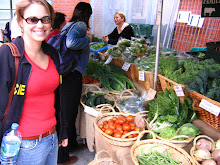 The second jardin collectif we visited in Brussels is long and narrow and tucked into the ground along a wall on a hill above the old train yard. It is filled with apple trees, currant bushes and blackberries and has many small to large annual vegetable beds with herbs and medicinal plants sprinkled throughout. No one really knows the history of the space, but it has a fig tree that was allegedly planted by Italian immigrants in the late nineteenth century. The fig tree enjoys the micro-climate of the wall and the south facing slope, and already has figs the size of baseballs. In Belgium! (...which, BTW, was as cold as February in Georgia while I was there...yikes!). The tree is clearly historic, and the organizers of the garden hope to use its historic status to protect the entire garden from "development" of one kind or another.
The second jardin collectif we visited in Brussels is long and narrow and tucked into the ground along a wall on a hill above the old train yard. It is filled with apple trees, currant bushes and blackberries and has many small to large annual vegetable beds with herbs and medicinal plants sprinkled throughout. No one really knows the history of the space, but it has a fig tree that was allegedly planted by Italian immigrants in the late nineteenth century. The fig tree enjoys the micro-climate of the wall and the south facing slope, and already has figs the size of baseballs. In Belgium! (...which, BTW, was as cold as February in Georgia while I was there...yikes!). The tree is clearly historic, and the organizers of the garden hope to use its historic status to protect the entire garden from "development" of one kind or another.Like the garden in Ghent, this garden also has its roots in labor and industry. The garden emerged four years ago as part of an attempt to reclaim a garbage dump that had grown under a bridge in an old train yard near the port. It is also a mere stones throw away from the "Little Manhatten" of Brussels, a central business district that the city planned and developed from the 1970s. The high rises are visible across the industrial wasteland from the vantage point of the garden.


The gardeners are both local and from neighborhoods far away. Some belong to permaculture organizations, some are just curious and sympathetic and some like, Abdil, are unemployed and looking for productive and meaningful work. The woman pictured below echoed the sentiments of gardeners in the first garden we visited. The garden belongs to us all. I am just planting these leeks here because they are ready to be planted. The spirit of cooperation and sharing is striking. No one seems to claim any part of this space as their own and everyone is welcome to whatever they want, whenever they want it. Needless to say, they have not had problems with theft or vandalism. It also doesn't hurt that you would never know it was there unless you knew, or you just happened to read the small sign on the only entrance.


This garden also sports a composting toilet housed in this terrific little building. To the left is the toilet, and to the right is a work room, which also doubles as a seed bank for the garden. The building is constructed of wood pieces that are soaked in oil, which are then surrounded by an insulating material, such as cork and then plastered with a kind of concrete, the name of which I don't remember. It has a green roof, tiled floors and an incredible view. It also comes with instructions.


This garden has had the benefit of some longevity, and having a strong community of workers with many skills, and apparently some access to capital. There is a greenhouse that one of the gardeners built and also two rain barrels that address access to reliable water, one of most intractable problems of community gardens.


There is also a small theater space in which children from the local community produced a play about nature. It is times like these that I feel the strictures of time and space. I want to be here for all of this, and to be there for all of that. I want to know all about this, here, and know all about that, there. I guess we just do the best we can, and this is me, doing the best I can to know about and share these imaginative, hopeful and joyful efforts of kind-hearted people.

Many times during this beautiful day of wandering through these oases of joy, we turned to say goodbye and our new friends were already lost to us, back in the bliss of tilling the soil and nurturing life. It makes my heart glad.

No comments:
Post a Comment